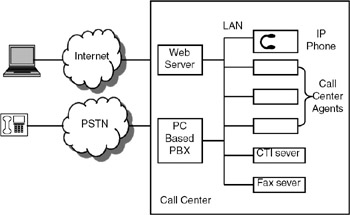35.6 CALL CENTERS
|
| < Day Day Up > |
|
35.6 CALL CENTERS
Every service organization—telephone service provider, hotel, bank, credit card company, and trading company—is now making efforts to provide efficient and timely service to its customers. To achieve this objective, call center technology is being widely used.
Nowdays, many developed countries are setting up call centers in developing countries such as India to gain the advantage of lower manpower costs and infrastructure costs. People at these call centers provide customer support to the overseas clients.
A call center is not a new technology, it is just a combination of various systems such as IVR, customer relations management software, fax-on-demand, voice over IP, and video conferencing. In this section, we will study call center applications and the technology ingredients.
Call centers use the CTI technologies extensively. These include IVR, fax-on-demand, voice and video over IP, and video conferencing.
35.6.1 Call Center Applications
Consider the typical operation of a customer support division of a credit card company. Prospective credit card customers call the support staff to obtain details of the credit card, and current customers call the support staff to make inquiries regarding their credit limits, to check whether payments are received, to make requests for monthly statement, and so on. Invariably, the customer calls the customer support telephone number and listens to music (while on hold) until one of the customer support persons is free to take the call. It is a waste of time to the customer. It may also happen that the support staff will not be able to provide the information requested by the customer immediately.
In call centers, the CTI technologies, in conjunction with customer relations management software, are used to provide efficient customer support by service organizations.
In this competitive world, any service organization cannot survive unless efficient customer support is provided. Call centers achieve this objective by integrating of various technologies and software, such as customer relations management (CRM) software, IVR, fax-on-demand, and such.
Typically, a customer will call up a call center and hear a prerecorded message indicating the various options available such as "dial 1 to hear about credit card facilities", "dial 2 to talk to a customer support specialist", "dial 3 to receive a brochure of the services provided". If the customer dials 1, the IVR system will be invoked. If she dials 2, the call will be routed to the customer support staff and if she dials 3, the system will prompt the user to key in the fax number, and the fax message will be sent to that fax machine. When the user dials 2, the call will be picked up by a call center agent who will invoke the CRM software to get the information related to the user and answer the queries.
This is a typical application of a call center. Call centers can be deployed by all service organizations.
35.6.2 Call Center Architecture
The typical architecture of a call center is shown in Figure 35.7. It consists of a LAN with one node for each call center agent. The server will have the CRM software, which can be invoked by any of the agents. In addition, there will be a CTI server which has the necessary hardware and software for the IVR application. A fax server will also be connected on the LAN to provide fax-on-demand service. For voice communication, a separate PBX can be installed or a PC-based PBX can be integrated that will have advanced features such as call routing and call hold, and direct inward dialing.

Figure 35.7: Call center architecture.
The various components that make up a call center are CRM software, IVR, fax-on-demand, automatic call distribution software, and PC-based PBX.
A customer can reach the call center through the PSTN by dialing the specified number of the customer support division. The IVR system will pick up the call, give the options to the user and, based on the user response, take action such as routing the call to a call center agent. This routing can be done intelligently by checking which agent is free and routing the call to that particular agent (thus avoiding playing music to the caller). This is known as automatic call distribution (ACD).
35.6.3 Internet-Enabled Call Centers
With the widespread use of voice over IP networks, there is no need to reach the call center through the PSTN. Internet-enabled call centers integrate voice over IP, fax over IP, and video over IP technologies to provide low-cost access to the call center.
In a typical scenario, a customer can invoke the Web page of a credit card company and click on customer support. The customer can then click on a telephone icon that automatically connects to the customer support staff so that the customer can interact through voice using VoIP protocols. As shown in Figure 35.7, an IP phone can be connected to the LAN directly. Using VoIP protocols, the call center agent can interact with the customer. Similarly, it is also possible to have video conferencing between the customer and the customer support manager.
In Internet-enabled call centers, voice and video over IP are used extensively to eliminate the need for long distance calls.
|
| < Day Day Up > |
|
EAN: 2147483647
Pages: 313